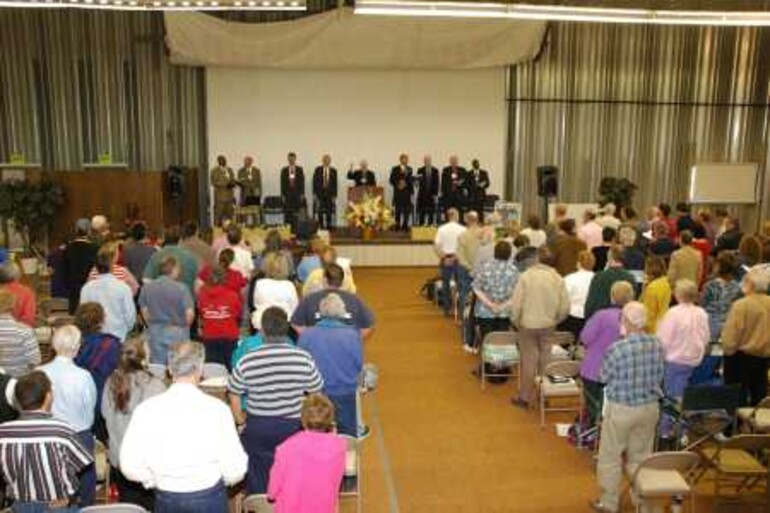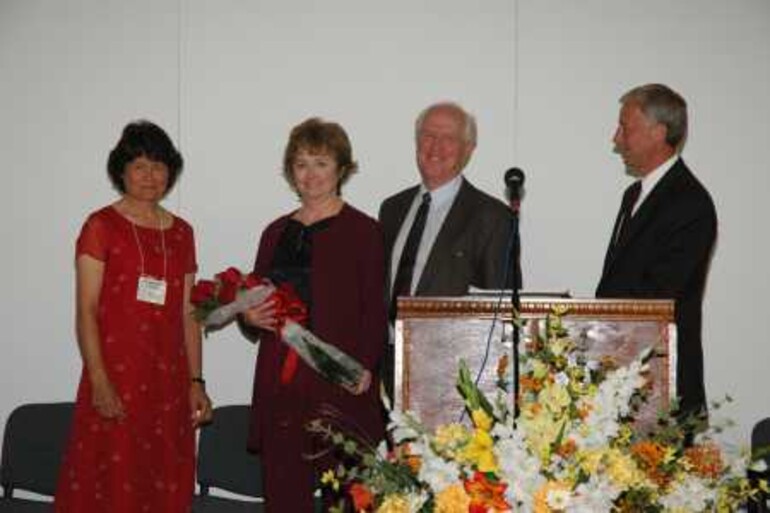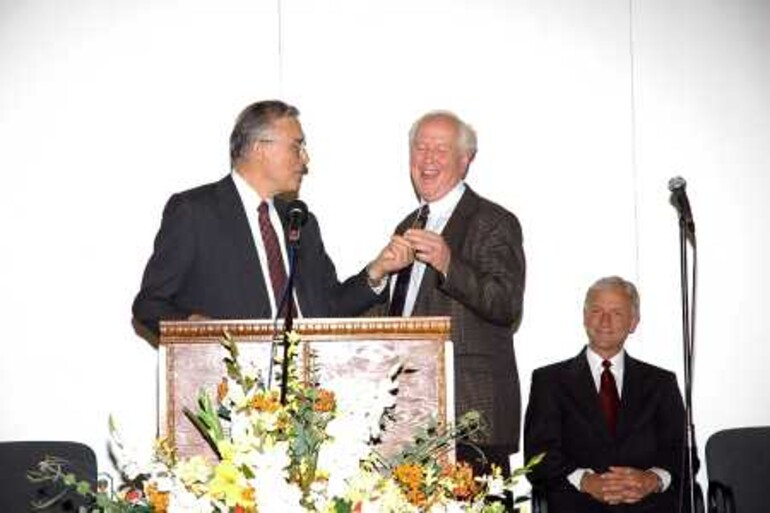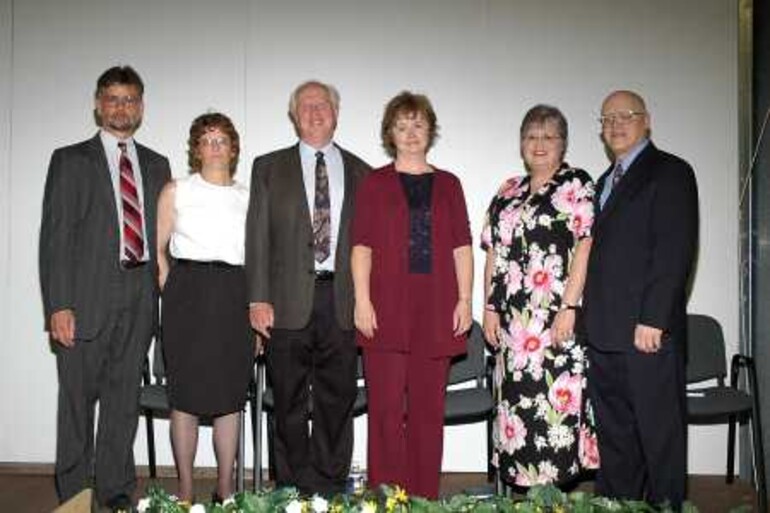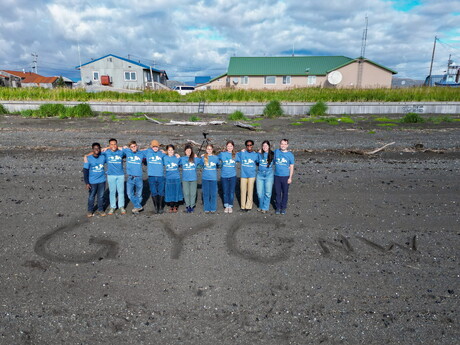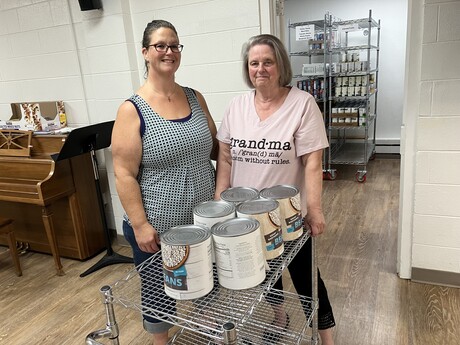Alaska Constituency Report More than 140 delegates came from throughout the wide expanses of the 49th state to convene the 14th triennial session of the Alaska Conference at Palmer on Sunday, June 20. The delegates considered the names put forward by the nominating committee, which had met during May, and voted favorably on all. Ken Crawford was elected president in secret balloting, replacing Russ Johnson, who announced his retirement in March. All incumbent officers and department directors were returned to office as well: Jim Kincaid as executive secretary and Sabbath school/Native ministries director; Harold Dixon as treasurer; John Kriegelstein, communication/education/youth; Neil Biloff, ministerial/evangelism; Lloyd Hallock, health/family life; Odea Sigh, stewardship; and Gary Waterhouse, government relations/public affairs and religious liberty. Crawford will also direct the conference's personal ministries efforts. Crawford and his wife, Colleen, have pastored in both Savoonga and Kodiak. Their children, David and Heather, were both born in Alaska as well (see below). Russ and Mary Johnson shared their plans to return to Idaho in retirement after 39 years of serving the Adventist Church in various capacities, including more than five years in the Alaska Conference. Johnson will be remembered as a model of a true Christian gentleman, even under the stressful responsibilities of his presidency. Many of the delegates came to the session inspired from several days of on-site camp meetings. The discussions on Sunday seemed to mirror the healthy, harmonious diversity that characterizes the Alaskan spirit at its best. Delegates took special interest in two agenda items. The first was the extensive review of the constitution and bylaws to conform more closely to the model recommended by the North American Division (NAD). A majority of the items were accepted as presented. In addition, delegates approved, after some discussion, a recommendation to extend the length of the term from three to four years, which would make Alaska consistent with all other Northwest conferences and many throughout the NAD as well. This decision will provide some financial savings, greater efficiency and allow for longer-range planning. Discussion also centered around whether or not to sell the present campground site in Palmer and consolidate both the campground and youth camp in a new location. After much discussion the delegate vote fell just short of the required 75 percent majority for approval, effectively tabling the issue. If property consolidation issues are not fully resolved in the near future, the newly elected leadership and executive committee will need to determine how much financial investment to put into necessary upgrades on the present campground facilities. Prior to the session, conference members in a series of town hall meetings had highlighted several important areas for growth during the coming term: increased membership; increased spirituality among pastors, teachers and lay leaders; increased unity through ownership, lay training and communication; increased visibility for each church and school; and increased presence and leadership in Native villages. Crawford’s remarks as incoming president echoed many of those areas, as he challenged delegates to be “a light in the world where the lights are rapidly going out and the hope of the world in these last days.”
Alaska Constituency Report
More than 140 delegates came from throughout the wide expanses of the 49th state to convene the 14th triennial session of the Alaska Conference at Palmer on Sunday, June 20.
The delegates considered the names put forward by the nominating committee, which had met during May, and voted favorably on all. Ken Crawford was elected president in secret balloting, replacing Russ Johnson, who announced his retirement in March. All incumbent officers and department directors were returned to office as well: Jim Kincaid as executive secretary and Sabbath school/Native ministries director; Harold Dixon as treasurer; John Kriegelstein, communication/education/youth; Neil Biloff, ministerial/evangelism; Lloyd Hallock, health/family life; Odea Sigh, stewardship; and Gary Waterhouse, government relations/public affairs and religious liberty. Crawford will also direct the conference's personal ministries efforts.
Crawford and his wife, Colleen, have pastored in both Savoonga and Kodiak. Their children, David and Heather, were both born in Alaska as well (see below).
Russ and Mary Johnson shared their plans to return to Idaho in retirement after 39 years of serving the Adventist Church in various capacities, including more than five years in the Alaska Conference. Johnson will be remembered as a model of a true Christian gentleman, even under the stressful responsibilities of his presidency.
Many of the delegates came to the session inspired from several days of on-site camp meetings. The discussions on Sunday seemed to mirror the healthy, harmonious diversity that characterizes the Alaskan spirit at its best.
Delegates took special interest in two agenda items. The first was the extensive review of the constitution and bylaws to conform more closely to the model recommended by the North American Division (NAD). A majority of the items were accepted as presented. In addition, delegates approved, after some discussion, a recommendation to extend the length of the term from three to four years, which would make Alaska consistent with all other Northwest conferences and many throughout the NAD as well. This decision will provide some financial savings, greater efficiency and allow for longer-range planning.
Discussion also centered around whether or not to sell the present campground site in Palmer and consolidate both the campground and youth camp in a new location. After much discussion the delegate vote fell just short of the required 75 percent majority for approval, effectively tabling the issue. If property consolidation issues are not fully resolved in the near future, the newly elected leadership and executive committee will need to determine how much financial investment to put into necessary upgrades on the present campground facilities.
Prior to the session, conference members in a series of town hall meetings had highlighted several important areas for growth during the coming term: increased membership; increased spirituality among pastors, teachers and lay leaders; increased unity through ownership, lay training and communication; increased visibility for each church and school; and increased presence and leadership in Native villages.
Crawford’s remarks as incoming president echoed many of those areas, as he challenged delegates to be “a light in the world where the lights are rapidly going out and the hope of the world in these last days.”




